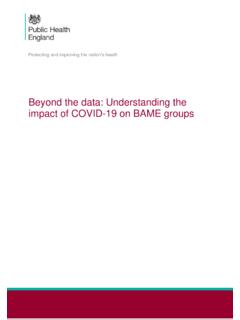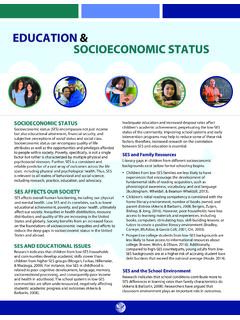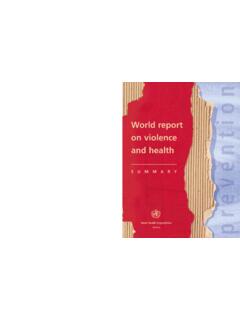Transcription of Environment and health risks: of social inequalities
1 Environment and health risks : of social inequalities Environment and health risks : a review of the influence and effects of social inequalities ABSTRACT This report serves as a background document for the policy brief on social and gender inequalities in Environment and health that was prepared for the Fifth Ministerial Conference on Environment and health (Parma, Italy, 10 12 March 2010). It provides an overview of the currently available evidence on the influences and effects of social and gender inequalities on environmental health risks . The evidence has been compiled for six environmental health challenges (air quality, housing and residential location, unintentional injuries in children, work-related health risks , waste management and climate change) as well as for gender-related inequalities and children s exposure.
2 Additional chapters present interventions on child-related environmental inequalities and social inequalities in environmental health risks in the Russian Federation. Although the evidence base on social inequalities and environmental risk is fragmented and data are often available for few countries only, it indicates that inequalities are a major challenge for environmental health policies. The review confirms that people living in adverse socioeconomic conditions in Europe can suffer twice as much from multiple and cumulative environmental exposures as their wealthier neighbours, or even more. Similarly, inequalities in exposure to environmental threats have been identified for vulnerable groups such as children and elderly people, low-education households, unemployed persons, and migrants and ethnic groups.
3 Only little evidence is available indicating that in some circumstances, well-off and advantaged social groups are more at risk. Irrespective of developmental status, environmental inequalities can be found in any country for which data are available. Despite lack of data from many Member States of the WHO European Region, social inequalities in environmental risk must therefore be considered a public health issue for each country and the whole Region. Keywords ENVIRONMENTAL health ENVIRONMENTAL EXPOSURE SOCIOECONOMIC FACTORS RISK FACTORS GENDER IDENTITY EUROPE Address requests about publications of the WHO Regional Office for Europe to: Publications WHO Regional Office for Europe Scherfigsvej 8 DK-2100 Copenhagen , Denmark Alternatively, complete an online request form for documentation, health information, or for permission to quote or translate, on the Regional Office web site ( ).
4 World health Organization 2010 All rights reserved. The Regional Office for Europe of the World health Organization welcomes requests for permission to reproduce or translate its publications, in part or in full. The designations employed and the presentation of the material in this publication do not imply the expression of any opinion whatsoever on the part of the World health Organization concerning the legal status of any country, territory, city or area or of its authorities, or concerning the delimitation of its frontiers or boundaries. Dotted lines on maps represent approximate border lines for which there may not yet be full agreement. The mention of specific companies or of certain manufacturers products does not imply that they are endorsed or recommended by the World health Organization in preference to others of a similar nature that are not mentioned.
5 Errors and omissions excepted, the names of proprietary products are distinguished by initial capital letters. All reasonable precautions have been taken by the World health Organization to verify the information contained in this publication. However, the published material is being distributed without warranty of any kind, either express or implied. The responsibility for the interpretation and use of the material lies with the reader. In no event shall the World health Organization be liable for damages arising from its use. The views expressed by authors, editors, or expert groups do not necessarily represent the decisions or the stated policy of the World health Organization. page iii CONTENTS Page Acknowledgements ..iv 1. social inequalities in health risk related to ambient air quality.
6 5 2. social inequalities in environmental risks associated with housing and residential location ..33 3. The social inequalities in health risks related to unintentional injuries among children ..76 4. social inequities in working Environment and work-related health risks ..105 5. inequalities , inequities, environmental justice in waste management and health ..127 6. social inequalities in environmental risks associated with global climate 7. Environmental inequalities among children and adolescents. A review of the evidence and its policy implications in Europe ..159 8. Summary report on interventions and actions to tackle inequities in physical activity in 9. Abstracts of country case studies on interventions and actions to tackle inequities in physical activity in 10. Gender inequities in Environment and health ..217 11. social inequality and environmental health in the Russian page iv Acknowledgements This evidence review has been compiled by the WHO European Centre for Environment and health (Bonn Office) and is based on three expert meetings on social inequalities and environmental risks organized in preparation to the Fifth Ministerial Conference on Environment and health (Parma, Italy, 10 12 March 2010): WHO meeting on Environment and health risks : the influence and effects of social inequalities , Bonn, Germany, 9 10 September 2009, supported by funds from the Federal Ministry of the Environment , Germany; Socio-environmentally determined health inequities among children and adolescents.
7 WHO/ health Behaviour in School-Aged Children (HBSC) Forum , Siena, Italy, 19 20 October 2009, supported by funds from the Tuscany Region, Italy and the National health Service (NHS) Scotland; Gender inequalities in Environment and health , Madrid, Spain, 11 12 November 2009, organized and funded by the Observatory of Women's health of the Ministry of health and social Policy of Spain. WHO is grateful for the contributions of the authors of the individual chapters as well as the comments made by participants at these meetings. page 1 Introduction social determinants of health have a strong influence on a wide diversity of health endpoints. The same is valid for the field of environmental health , as the exposure to environmental risk factors is also unequally distributed, and this unequal distribution is often related to social characteristics such as income, social status, employment and education, but also non-economic aspects such as gender, age or ethnicity.
8 However, depending on the environmental risk and the risk group considered, the magnitude of inequality varies largely. The realization of the social pattern in risk exposure has resulted in the adoption of methodologies to formally take into account these effects. Typically, the health risks depending on socioeconomic factors have a strong potential for acting as confounders of the parameter of interest, the association between health and the respective risk factor. Standardization techniques are applied to remove their contribution and assess the risk factor- health association independent of the influence of socioeconomic factors. This practice has greatly contributed to better assessment of various environmental risks , and is nowadays firmly established in environmental epidemiology.
9 However, this also reflects the strong expectation that socioeconomic factors are associated to environmental exposures. Still, complete understanding of how environmental risk factors operate in the reality of the social Environment has not been reached, and would be very informative especially for designing effective policy responses. As a first step towards better understanding of the impact of social inequalities on the distribution of environmental risks , this report presents a compilation of European evidence on the impact of social determinants on environmental risk. This report mainly draws from contributions to a background document for the WHO expert meeting on Environment and health risks : the influence and effects of social inequalities funded by the Federal Ministry of the Environment , Germany (Bonn, 9 10 September 2009).
10 1 It incorporates additional contributions from expert meetings on social inequalities and environmental risks which were supported by funds from the Tuscany Region, Italy and the National health Service Scotland ( Socio-environmentally determined health inequities among children and adolescents. WHO/ health Behaviour in School-Aged Children (HBSC) Forum , Siena, Italy, 19 20 October 2009)2 and the Ministry of health of Spain ( Gender inequalities in Environment and health , Madrid, Spain, 11 12 November 2009).3 This review report focuses on evidence from the Member States of the WHO European Region but also recognizes key evidence from outside Europe helpful to understand the associations between social factors and environmental risk exposure. It aims at contributing towards an evidence base for addressing environmental inequalities and is one of the documents made available to the participants of the Fifth Ministerial Conference on Environment and health (10 12 March 2010 Parma, Italy).
















